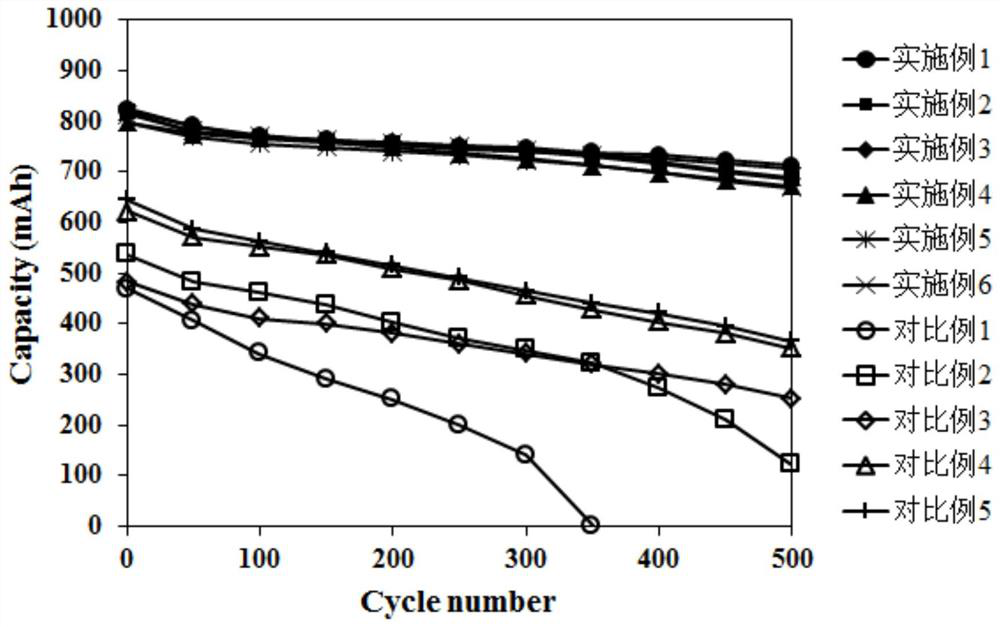Secondary battery electrolyte, preparation method thereof and battery
A secondary battery and electrolyte technology, applied in secondary batteries, secondary battery repair/maintenance, circuits, etc., can solve the problems of not meeting the needs of practical applications, high cost of LiFSI, limited improvement effect, etc., to achieve improved Fast charging cycle performance, reduced polarization, and reduced migration resistance
- Summary
- Abstract
- Description
- Claims
- Application Information
AI Technical Summary
Problems solved by technology
Method used
Image
Examples
Embodiment 1
[0030] An electrolyte solution for secondary batteries, using ethylene carbonate, dimethyl carbonate, bis(2,2-difluoroethyl)ether and trichloroethane as solvents, the volume ratio of the four solvents is 1:1:0.2 : 0.2.
[0031] Using LiPF 6 As an electrolyte, lithium nitrate and sulfur dioxide are also included in the secondary battery electrolyte.
[0032] The steps of preparing the above secondary battery electrolyte are as follows:
[0033] S1. Weigh 1000ml of ethylene carbonate, 1000ml of dimethyl carbonate, 200ml of bis(2,2-difluoroethyl) ether and 200ml of trichloroethane, and add them into the reaction flask for mixing and stirring, keeping the temperature at 20°C , and stir evenly to obtain the first mixture;
[0034] S2, add LiPF again in the first mixture 6 , keeping the temperature in the reaction flask at 20°C, add to LiPF 6 The molar concentration of reaches 0.8mol / L, obtains the second mixture;
[0035] S3, adding lithium nitrate to the second mixture, keep...
Embodiment 2
[0039] An electrolyte solution for a secondary battery, using propylene carbonate, diethyl carbonate, bis(2,2,2-trifluoroethyl)ether and tetrachloroethane as solvents, and the volume ratio of the four solvents is 1:1 :0.4:0.4.
[0040] Using LiPF 6 As an electrolyte, sodium nitrate and sulfur dioxide are also included in the secondary battery electrolyte.
[0041] The steps of preparing the above secondary battery electrolyte are as follows:
[0042] S1. Weigh 1000ml propylene carbonate, 1000ml diethyl carbonate, 400ml bis(2,2,2-trifluoroethyl) ether and 400ml tetrachloroethane respectively, add them to the reaction flask for mixing and stirring, and keep the temperature at 22°C, stir evenly to obtain the first mixture;
[0043] S2, add LiPF again in the first mixture 6 , keeping the temperature in the reaction flask at 22°C, add to LiPF 6 The molar concentration of reaches 0.1.2mol / L, obtains the second mixture;
Embodiment 3
[0048]An electrolyte solution for a secondary battery, using ethyl methyl carbonate, bis(2-fluoroethyl) ether, bis(1-fluoro-2,2,2-trifluoroethyl) ether, dichloroethane and ethyl chloride Alkanes are used as solvents, and the volume ratio of the five solvents is 1:0.2:0.3:0.2:0.3.
[0049] Using LiPF 6 As an electrolyte, lithium nitrite and sulfur dioxide are also included in the secondary battery electrolyte.
[0050] The steps of preparing the above secondary battery electrolyte are as follows:
[0051] S1. Weigh 1000ml ethyl methyl carbonate, 200ml bis(2-fluoroethyl) ether, 300ml bis(1-fluoro-2,2,2-trifluoroethyl) ether, 200ml dichloroethane and 300ml chlorine Add ethane into the reaction flask for mixing and stirring, keep the temperature at 24°C, and stir evenly to obtain the first mixture;
[0052] S2, add LiPF again in the first mixture 6 , keeping the temperature in the reaction flask at 24°C, add to LiPF 6 The molar concentration of reaches 1.6mol / L, obtains the s...
PUM
 Login to View More
Login to View More Abstract
Description
Claims
Application Information
 Login to View More
Login to View More - R&D
- Intellectual Property
- Life Sciences
- Materials
- Tech Scout
- Unparalleled Data Quality
- Higher Quality Content
- 60% Fewer Hallucinations
Browse by: Latest US Patents, China's latest patents, Technical Efficacy Thesaurus, Application Domain, Technology Topic, Popular Technical Reports.
© 2025 PatSnap. All rights reserved.Legal|Privacy policy|Modern Slavery Act Transparency Statement|Sitemap|About US| Contact US: help@patsnap.com



